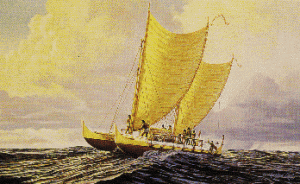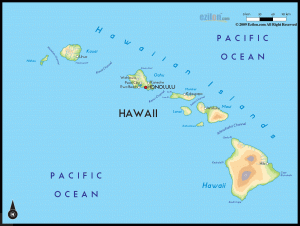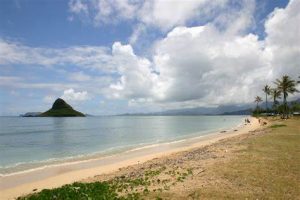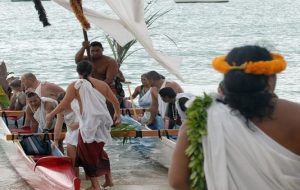
 As the world first began to be settled, the Hawaiian Islands were discovered, and in approximately 400AD Polynesians from the Marquesas Islands traveled the 2000 miles distance to Hawaii’s Big Island in canoes. To get to Hawaii, they navigated by the sun and stars, reading the winds, currents, and seabirds’ flight. The Polynesians sailed across the open ocean in great double-hulled canoes. The Polynesians brought with them items essential to their survival, including pigs, dogs, and chickens; the roots of kalo (a root vegetable and one of the most complex carbohydrates on the planet) and sweet potato; the seeds and saplings of coconut, banana, sugar cane, and other edible and medicinal plants. Polynesians were well-established on the islands when Polynesians from the Society Islands arrived in Hawaii. These newcomers became the new rulers of Hawaii. After a time of voyaging back and forth between the Society Islands and the Hawaiian Archipelago, contact with southern Polynesia ceased. During the 400 years of isolation that followed, a unique Hawaiian culture developed. That is similar to what happened when the pilgrims came to the new world…present-day United States. Once away from the culture one comes from, new ideas and new skills begin to form.
As the world first began to be settled, the Hawaiian Islands were discovered, and in approximately 400AD Polynesians from the Marquesas Islands traveled the 2000 miles distance to Hawaii’s Big Island in canoes. To get to Hawaii, they navigated by the sun and stars, reading the winds, currents, and seabirds’ flight. The Polynesians sailed across the open ocean in great double-hulled canoes. The Polynesians brought with them items essential to their survival, including pigs, dogs, and chickens; the roots of kalo (a root vegetable and one of the most complex carbohydrates on the planet) and sweet potato; the seeds and saplings of coconut, banana, sugar cane, and other edible and medicinal plants. Polynesians were well-established on the islands when Polynesians from the Society Islands arrived in Hawaii. These newcomers became the new rulers of Hawaii. After a time of voyaging back and forth between the Society Islands and the Hawaiian Archipelago, contact with southern Polynesia ceased. During the 400 years of isolation that followed, a unique Hawaiian culture developed. That is similar to what happened when the pilgrims came to the new world…present-day United States. Once away from the culture one comes from, new ideas and new skills begin to form.
The Hawaiian people were highly skilled farmers and fishermen, who lived in small communities ruled by chieftains who battled one another for territory. The new Hawaiian culture was a highly stratified society with strictly maintained classes of people. The chiefs headed the social pyramid and ruled over the land. The highest class, the Kahuna (professionals) were highly regarded and sometimes feared, they were experts on religious ritual or specialists in canoe-building, herbal medicine, and healing. The middle class, the maka`ainana (commoners) farmed, fished, built walls, houses, and fishponds…and paid taxes to the paramount chiefs and his chiefs. Kauwa, the lowest class, were outcasts or slaves. I can’t say that the class society was fair, because it really wasn’t, but many societies of that era were ruled in that way, and in reality, this class society still exists…maybe with slight differences, but it still exists.
In many ways, the culture was quite oppressive, especially to women. A system of laws known as Kanawai enforced Hawaii’s social order. Certain people, places, things, and times were considered sacred. Being near them was kapu, or forbidden except to a very privileged few. Women ate apart from men and were restricted from eating pork, coconuts, bananas, or a variety of other foods. Kapu regulated fishing, planting, and the harvesting of other resources, thus ensuring their conservation. Any breaking of kapu disturbed the stability of society, and the punishment for breaking this law was usually death.
Still, even with the strict laws, village life was rich and interesting. Hawaiians fished in coastal waters and collected shellfish, seaweed, and salt along the shore. They raised pigs, dogs, and chickens and harvested sweet potatoes, kalo, and other crops. Men pounded kalo into poi, which is the staple food of Hawaiians, while women beat the inner bark of wauke (paper mulberry) into kapa (bark cloth). The sounds of taro pounding and 
 kapa beating were rhythmical signatures of Hawaiian village life. That changed dramatically after Captain James Cook arrived in 1778 and introduced the rest of the world to Hawaii. Cook, who named the islands after the Earl of Sandwich, returned a year later and was killed in a confrontation with Hawaiians at Kealakekua Bay, on Hawaii’s Big Island. Still his impact on the state of Hawaii remains.
kapa beating were rhythmical signatures of Hawaiian village life. That changed dramatically after Captain James Cook arrived in 1778 and introduced the rest of the world to Hawaii. Cook, who named the islands after the Earl of Sandwich, returned a year later and was killed in a confrontation with Hawaiians at Kealakekua Bay, on Hawaii’s Big Island. Still his impact on the state of Hawaii remains.


One Response to Populating Hawaii